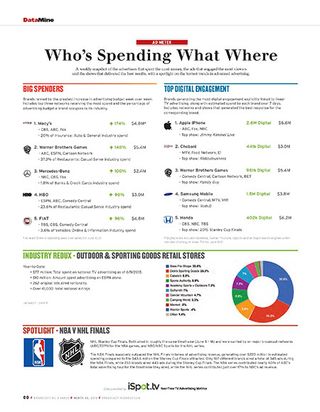Guest Post: A Tale of Two Finals

June saw the airing of dueling sports playoff series—The NBA Finals and the NHL Stanley Cup Finals.
Both aired in the same timeframe, with the NBA’s championship series running from June 4 through June 16 and the NHL’s games from June 3 through June 15. Both were aired on major broadcast networks, with ABC presenting the NBA games (along with ESPN) while NBC owned the NHL series (along with NBC Sports). And both best-of-seven series lasted only six games.
But the similarities end there. The NBA Finals massively outpaced the NHL Finals in terms of advertising revenue, generating over $220 million in estimated spending compared to the $43.6 million the Stanley Cup Finals attracted, which has implications both in terms of network revenue impact and brand advertiser effect.
Network Impact
The impact on the different networks airing these finals is striking. The NBA series contributed nearly 60% of ABC’s total advertising haul for the timeframe they aired. Meanwhile the NHL series contributed just over 17% to NBC’s ad revenue over their airing dates (yet was about 50% of NBC Sports’ revenue).
These figures will likely come into play when it comes time for the networks and the leagues to negotiate new carriage contracts. The NHL in particular has only recently returned to network TV after several years of cable banishment. While its advertising take looks paltry compared to basketball, baseball, and football playoffs, the NHL has seen an increase in revenue over the years. Last year was particularly lucrative as the Finals featured teams from two huge media markets—the LA Kings and NY Rangers. Whether relatively smaller markets like Chicago and Tampa Bay can continue the trend to NBC’s approval is a factor worth following.
Brand Effect
Broadcasting & Cable Newsletter
The smarter way to stay on top of broadcasting and cable industry. Sign up below
Brands were happy to shell out more for less on the NBA Finals than the NHL Stanley Cup Finals. Only 187 brands aired a total of 345 ads during the NBA Finals, while 233 brands aired 443 ads during the Stanley Cup Finals.
Movie studios led the charge for the basketball finals. Of the top five brands that spent the most on advertising during the games, three were movie studios. Columbia Pictures and Universal Pictures were the two highest-spending advertisers, and with Warner Bros. as the fourth-highest spender, they collectively contributed over 12% of the total advertising revenue collected.
Meanwhile, cars and car insurance headlined in hockey. Lexus was the top spender and Honda the fourth. Together, they contributed just under 9% of the total advertising revenue collected for the series. But Auto Insurance had a strong showing as well. GEICO was the second-highest spender with 4.7% of the total, while USAA spent the most on a single ad, $1.5 million for 17 airings.
But putting aside the comparative stats for a moment, it’s also worth examining how brands navigated both sports finales. Advertising against special televised events can have a significant payoff for brands that employ the strategy wisely. Take Samsung, which took advantage of both finals series to promote its Galaxy 6 Edge smartphone.
Of the $10 million Samsung spent on airing the “6 v 6: Wireless Charging, Wide Angle Selfie” ad in the timeframe that both finals took place, over $6 million went to placing that ad on either series. It spent $5.5 million to air that ad 23 times across all the NBA Finals games—the most spent on a single ad for the entire series—while nearly $900,000 went to airing the ad eight times across the NHL games.
Both investments paid off. Of all the digital chatter generated by that ad—meaning online views, social actions, and web searches—over 25% of it came as a result of the ads that aired during the NBA Finals and over 10% from the NHL games. Taken together, the money Samsung spent on ads for both sports’ finals generated over a third of the digital engagement for the device.
What’s more, that ad generated more digital engagement than any ad aired on TV for the first week of both finals series, beating out even Apple despite its rival just holding its WWDC Keynote that introduced the Apple Music service.
So, while it’s interesting to measure how different sports can attract different levels of advertising, it’s equally interesting (and arguably more important) to examine how brands can take advantage of the wide spectrum of sports fans out there when determining their advertising strategy.
